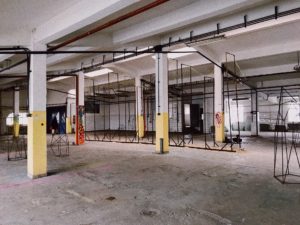How to Fix Dusty Concrete
Day in and day out, team members hustle through your facility, both on foot and driving machinery, and things get pretty messy. Your flooring takes a beating, and dust flies everywhere, making folks sneeze, cough and just feel uncomfortable. You’re dusty concrete is probably to blame, but it can be fixed. Let’s walk through what causes these problems and how to fix dusty concrete.
What Causes Dusty Concrete?
A variety of factors influence whether concrete dusting becomes problematic, like surface abrasions, moisture loss 
One thing to remember is to let the concrete cure for 28 days so it develops compressive strength, capable of withstanding foot traffic and machinery. This is also important because after concrete is poured, water bleeds to the surface, carrying sand and cement particles with it. After the concrete has dried, these particles crumble and create the dust you’re trying to avoid.
Solutions for Dusty Concrete
The simple solution for a dusty floor is to clean it, right? While this may work from time to time, the maintenance is difficult. That’s you need more permanent solutions for how to fix dusty concrete. That’s where polishing comes in. Polished floors are ideal because they’re easier to clean, making maintenance easier and more cost effective. But what kind of polished surface is best? Our top picks: sealers and coatings.
Apply Concrete Sealers
Sealers are long-term protectants designed to look good and improve the longevity of concrete floors. What’s nice about dust proof sealers like sodium or lithium silicate densifiers is that they’re easy to apply, relatively inexpensive and don’t alter the appearance of your flooring surface. These densifiers penetrate concrete pores, making the floor up to 45% stronger than untreated concrete. After using a densifier, an optional next step is to apply a water repellent sealer. This way, your facility is protected not only from dusting, but from problems caused by moisture, too.
Opt for Concrete Coatings
If your issue can’t be solved with a sealer, try a coating made of acrylic, epoxy or urethane instead. Note that coatings do somewhat change the visible flooring surface, however. Like sealers, though, coatings penetrate the pores to create strength and provide top layer protection. This prevents abrasions, eliminating the risk of concrete dusting.
But which coating is best? Acrylic is usually sufficient, but if you have a high-traffic facility, urethane may be the better bet.
Eliminate Dusty Concrete Once and For All
From proper flooring installation to the right protective coatings, your concrete floor can really shine (and last for years to come). Take the right steps to ensure concrete longevity and provide a clean facility with tried-and-true steps for how to fix dusty concrete. Get in touch with McLean to get a quote and start your project today!
